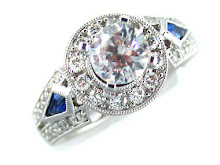

The "Art Nouveau" (fr. "new art") movement was one of the first departures from classical art and design towards modernism. The '
 Modernism' and Art Nouveau movements occurred during what was known in France as the "Belle Époque," or "beautiful era" period of the late 19th and early 20th centuries.This time period did not last too long, but created many sought after collectibles, art, architecture and jewelry.
Modernism' and Art Nouveau movements occurred during what was known in France as the "Belle Époque," or "beautiful era" period of the late 19th and early 20th centuries.This time period did not last too long, but created many sought after collectibles, art, architecture and jewelry.The Art Nouveau movement focused heavily on the themes of nature, fantasy, and the female form. Exotic floral motifs with animals, birds, butterflies, dragonflies, peacock
 feathers and marsh plants were combined with graceful feminine imagery or fairies, mermaids and nymphs, complete with their waves of twisting hair.
feathers and marsh plants were combined with graceful feminine imagery or fairies, mermaids and nymphs, complete with their waves of twisting hair.Here are some distinctive features of the period:
- Semi-precious stones gained even more popularity than diamonds: the aesthetics of design were considered more important than value of materials, moonstone, opal,
 amethyst, citrine, peridot and pearls were widely used.
amethyst, citrine, peridot and pearls were widely used. - Emphasis on the designer as artist motivated using of enameling techniques in jewelry, such as cloisonne (partitions formed by gold wire into which enamel is poured); basse-taille (in which an engraved design in the metal is covered with, but still visible through, a transparent enamel) and plique-a-jour (in which the backing metal is removed from the translucent enamel after firing, resulting in stained glass effect).

- Nature motif: butterflies, dragonflies, flowers and birds, enameled and decorated with pearls or other semi-precious stones.
- Female silhouette with long, flowing hair.


No comments:
Post a Comment